ALREADY A PAID SUBSCRIBER? SIGN IN
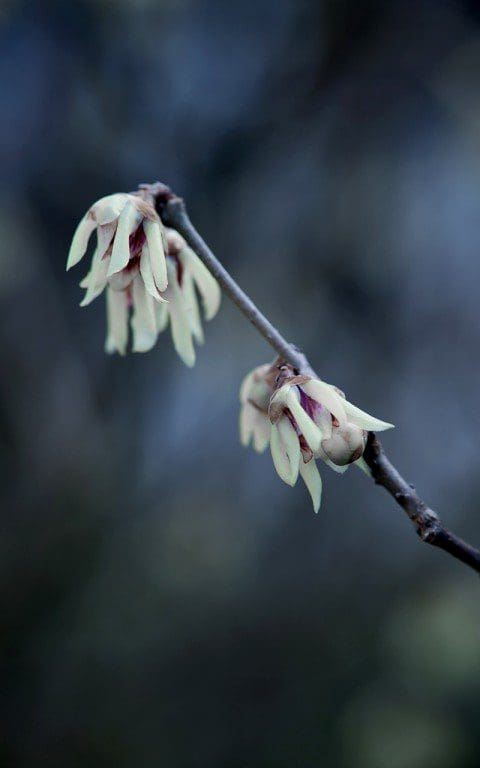 Chimonanthus praecox
Until recently I have not had the place to plant one for myself, so I have gone out of my way to find wintersweet a home in clients’ gardens in the knowledge that they too will reap the rewards in January and February. This vicarious pleasure has been lived out fully at a project I am working on in Shanghai where I have designed a series of gardens that seat a number of restored Ming and Qing dynasty merchant’s houses within a forest of ancient camphor trees.
In the process of understanding how to interpret the planting, my research into Chinese gardens revealed that wintersweet was one of the natives used repeatedly in the pared-back palette of auspicious plants. The winter perfume was revered and the dried flowers were used to scent linen much as we use lavender here. Come the summer the long, lime green leaves are also scented when crushed. I have used them throughout the site as free-standing shrubs, placed close to the junction of paths where you are already pausing, but are then halted by the surprise of perfume.
Chimonanthus praecox
Until recently I have not had the place to plant one for myself, so I have gone out of my way to find wintersweet a home in clients’ gardens in the knowledge that they too will reap the rewards in January and February. This vicarious pleasure has been lived out fully at a project I am working on in Shanghai where I have designed a series of gardens that seat a number of restored Ming and Qing dynasty merchant’s houses within a forest of ancient camphor trees.
In the process of understanding how to interpret the planting, my research into Chinese gardens revealed that wintersweet was one of the natives used repeatedly in the pared-back palette of auspicious plants. The winter perfume was revered and the dried flowers were used to scent linen much as we use lavender here. Come the summer the long, lime green leaves are also scented when crushed. I have used them throughout the site as free-standing shrubs, placed close to the junction of paths where you are already pausing, but are then halted by the surprise of perfume.
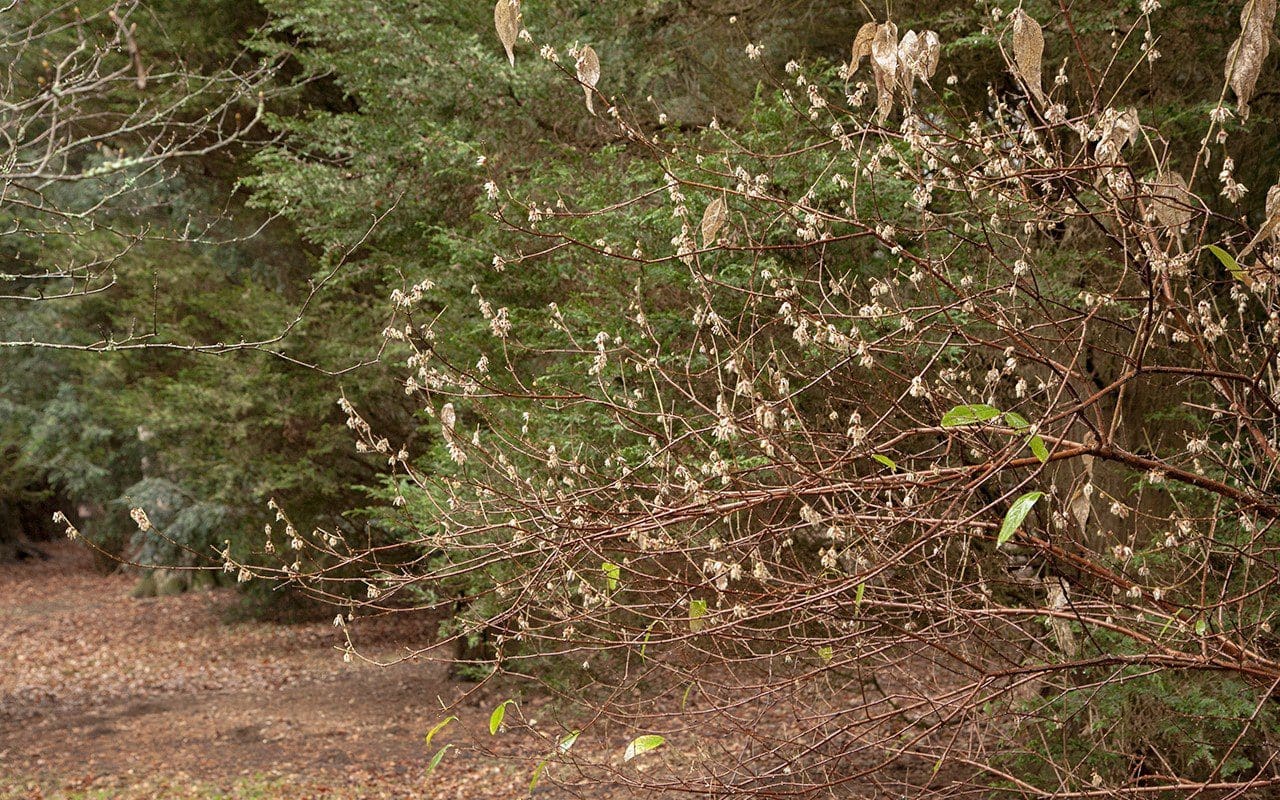
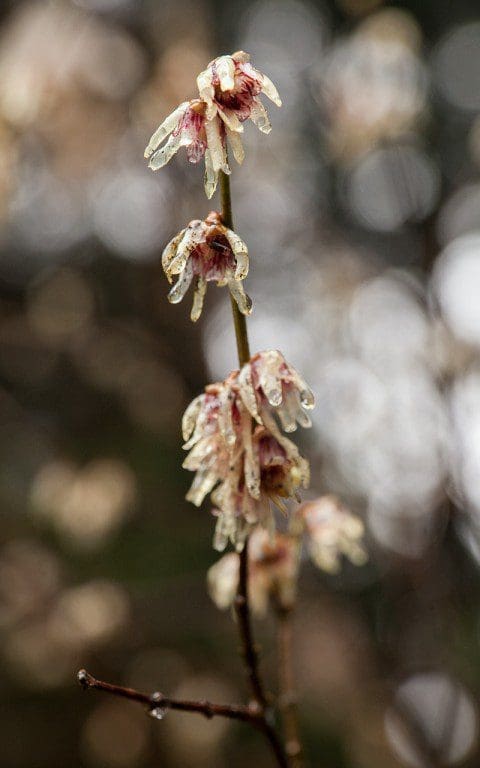 Chimonanthus praecox at Westonbirt Arboretum
In its native habitat in open woodland Chimonanthus praecox can grow to as much as thirteen metres. In cultivation it forms a nicely branched shrub of three by three metres and, being well-behaved, it has been a mainstay of Chinese gardens for more than 1000 years. It was first introduced to Japan in the late 17th century as a garden plant and then to Britain a century later, arriving at Croome Court in 1766.
If you read up about it, books repeatedly state that it needs the radiated heat of a south or west wall to ripen its wood sufficiently to flower well. The half-radius of Lutyens’ Rotunda at Hestercombe House, where Gertrude Jekyll’s original planting of 1904 still survives, beautifully demonstrates its use as a wall-trained shrub. Indeed, you see it flowering most prolifically on the hottest part of the wall.
As it is hardy to -10°C it is happy out in the open and I have found it to be far more adaptable in this country where not too far north. The specimen at Westonbirt Arboretum, for instance, is flowering well in open woodland, so it is worth breaking the rules if you dare.
Chimonanthus praecox at Westonbirt Arboretum
In its native habitat in open woodland Chimonanthus praecox can grow to as much as thirteen metres. In cultivation it forms a nicely branched shrub of three by three metres and, being well-behaved, it has been a mainstay of Chinese gardens for more than 1000 years. It was first introduced to Japan in the late 17th century as a garden plant and then to Britain a century later, arriving at Croome Court in 1766.
If you read up about it, books repeatedly state that it needs the radiated heat of a south or west wall to ripen its wood sufficiently to flower well. The half-radius of Lutyens’ Rotunda at Hestercombe House, where Gertrude Jekyll’s original planting of 1904 still survives, beautifully demonstrates its use as a wall-trained shrub. Indeed, you see it flowering most prolifically on the hottest part of the wall.
As it is hardy to -10°C it is happy out in the open and I have found it to be far more adaptable in this country where not too far north. The specimen at Westonbirt Arboretum, for instance, is flowering well in open woodland, so it is worth breaking the rules if you dare.
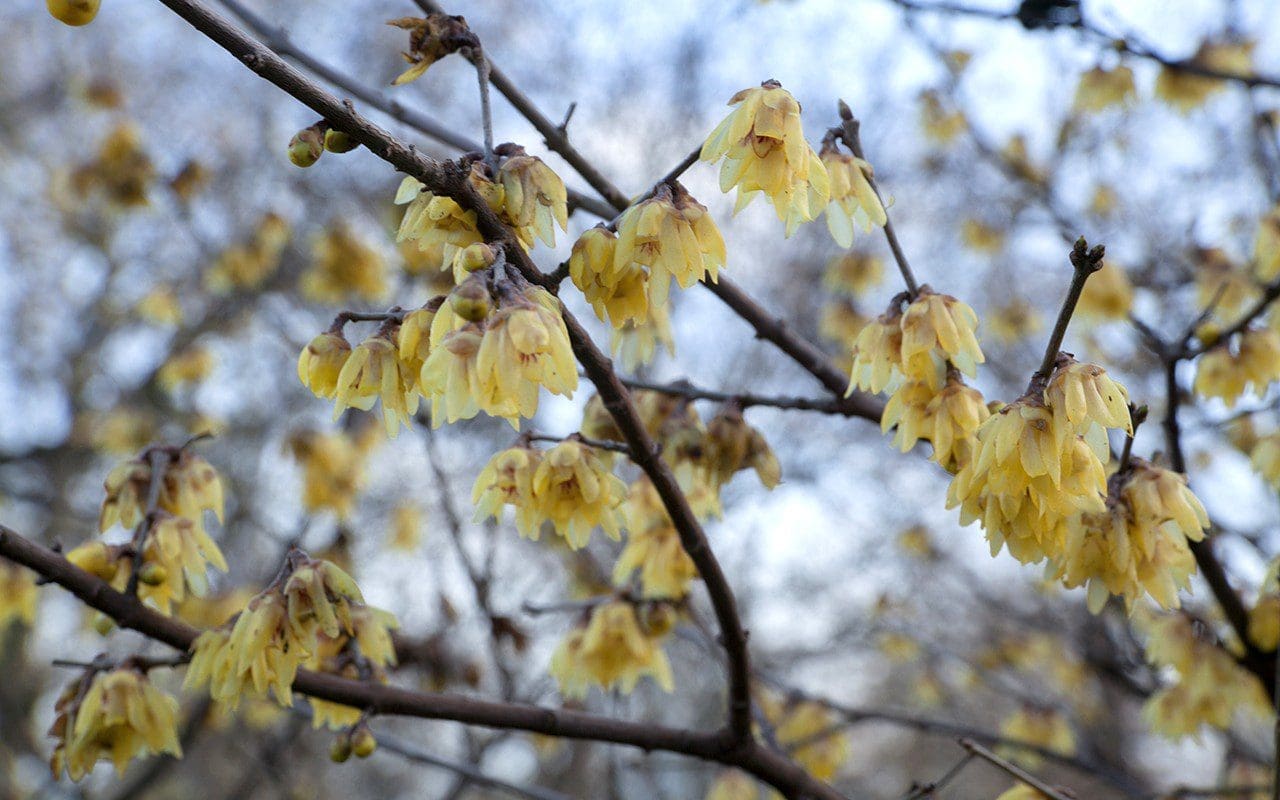 Chimonanthus praecox ‘Luteus’
Grown from seed wintersweet can take up to fifteen years to flower, a containerised plant five or eight after planting, much like a wisteria. As a species Chimonanthus praecox is variable, but there are a small number of named forms commercially available.
In the Winter Garden I designed at Battersea Park (main image) I have used C. p. ‘Luteus’ as a perfumed welcome by the Sun Gate at the garden’s entrance to draw people in. I am not completely sure the plant supplied is the real ‘Luteus’. Although the flowers register a strong beeswax yellow they have a very slight staining to the central boss, which ‘Luteus’ is not supposed to have. ‘Sunburst’ is yellower still, whilst C. p. ‘Grandiflorus’ has a larger, more open flower which is paler and more translucent. A red stain suffusing the central boss is more typical of the species, which is also reputed to be more heavily scented than the above selections, although I’ve never been able to compare them.
Chimonanthus praecox ‘Luteus’
Grown from seed wintersweet can take up to fifteen years to flower, a containerised plant five or eight after planting, much like a wisteria. As a species Chimonanthus praecox is variable, but there are a small number of named forms commercially available.
In the Winter Garden I designed at Battersea Park (main image) I have used C. p. ‘Luteus’ as a perfumed welcome by the Sun Gate at the garden’s entrance to draw people in. I am not completely sure the plant supplied is the real ‘Luteus’. Although the flowers register a strong beeswax yellow they have a very slight staining to the central boss, which ‘Luteus’ is not supposed to have. ‘Sunburst’ is yellower still, whilst C. p. ‘Grandiflorus’ has a larger, more open flower which is paler and more translucent. A red stain suffusing the central boss is more typical of the species, which is also reputed to be more heavily scented than the above selections, although I’ve never been able to compare them.
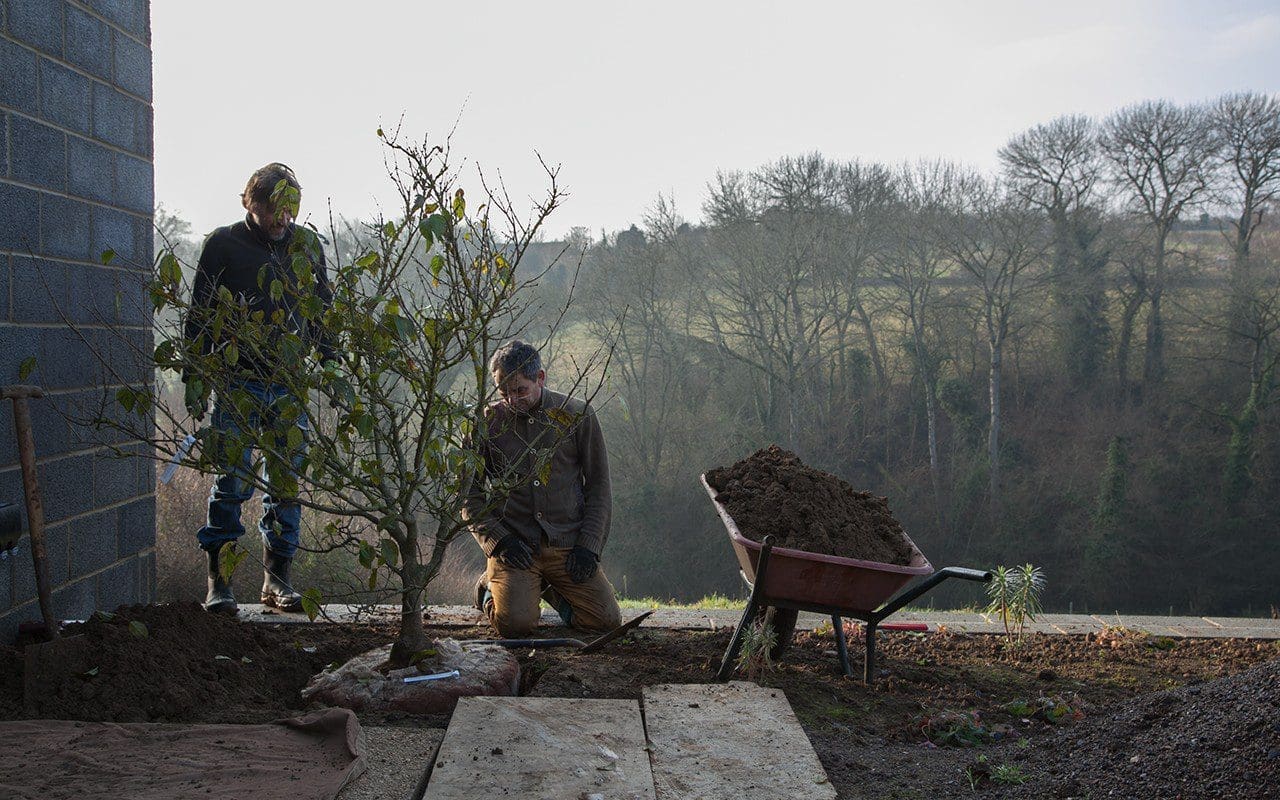 Planting the new wintersweet at Hillside
As I have waited this long to be able to plant one for myself and am impatient for flower, I went to Karan Junker for a mature, field-grown specimen. Her seed came to her via Roy Lancaster from a batch originally selected by the great Japanese botanist and plant collector Mikinori Ogisu. There is a fabled pinky-red clone in Japan and the seed potentially included these genes. Just before Christmas I planted my ten-year-old by the studio door so that the perfume is not wasted and today it has broken the first of a half dozen buds to reveal a form that is clear waxy yellow. There are no dark markings, but the scent – my February fix and instant reminder of my childhood discovery – is bewitching. A winter without wintersweet would be a duller season, unmarked by this strange, scented treasure.
Planting the new wintersweet at Hillside
As I have waited this long to be able to plant one for myself and am impatient for flower, I went to Karan Junker for a mature, field-grown specimen. Her seed came to her via Roy Lancaster from a batch originally selected by the great Japanese botanist and plant collector Mikinori Ogisu. There is a fabled pinky-red clone in Japan and the seed potentially included these genes. Just before Christmas I planted my ten-year-old by the studio door so that the perfume is not wasted and today it has broken the first of a half dozen buds to reveal a form that is clear waxy yellow. There are no dark markings, but the scent – my February fix and instant reminder of my childhood discovery – is bewitching. A winter without wintersweet would be a duller season, unmarked by this strange, scented treasure.
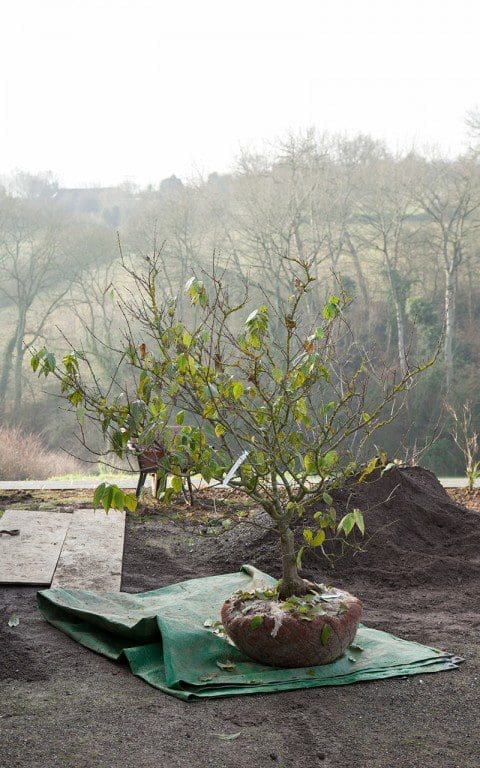 Words: Dan Pearson / Photographs: Huw Morgan
Words: Dan Pearson / Photographs: Huw Morgan The Lonicera fragrantissima broke the first flower buds in the last week of December, closing the year with a perfumed offering on the cool air. At the moment, for this is still a young garden, it is one of the few flowers that brave the shortest days. Also flowering now is the witch hazel, Hamamelis x intermedia ‘Barmstedt Gold’. Its spidery yellow flowers have a light bergamot fragrance and some sprigs for the house are precious for their scarcity. Winter honeysuckle itself is an easy thing. Indeed, it will grow in the toughest of places on next to nothing. It was one of the solitary survivors amongst the undergrowth when I moved to the garden in Peckham almost twenty years ago. I dug it out, saving a layering to pass on and not erase it completely from memory. With limited space I wanted something more choice in its place back then and so enjoyed it vicariously in client’s gardens until we moved here and had room for it.
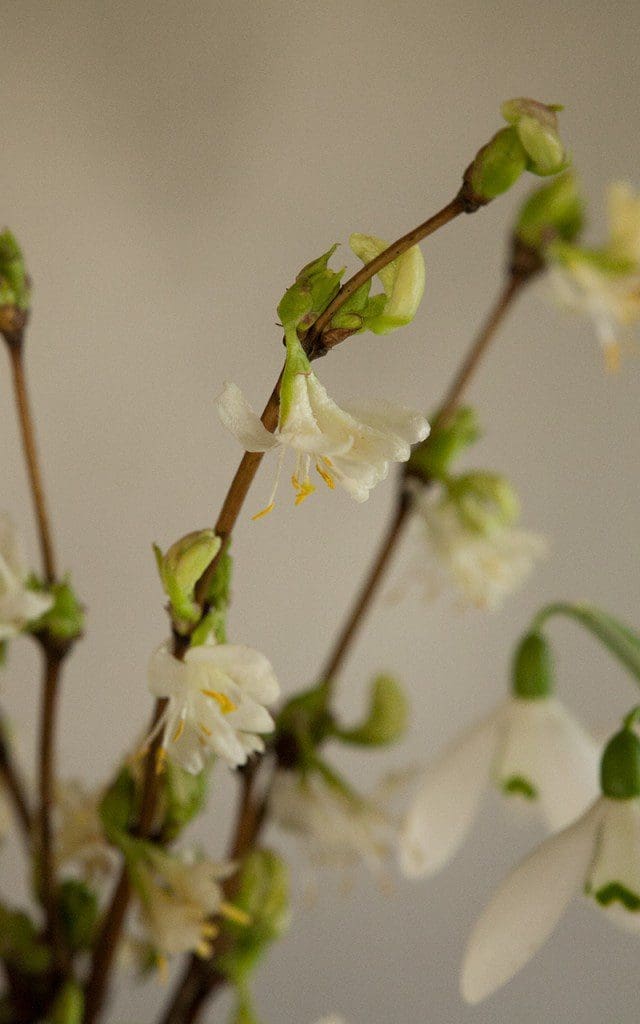 Lonicera fragrantissima
Lonicera fragrantissima
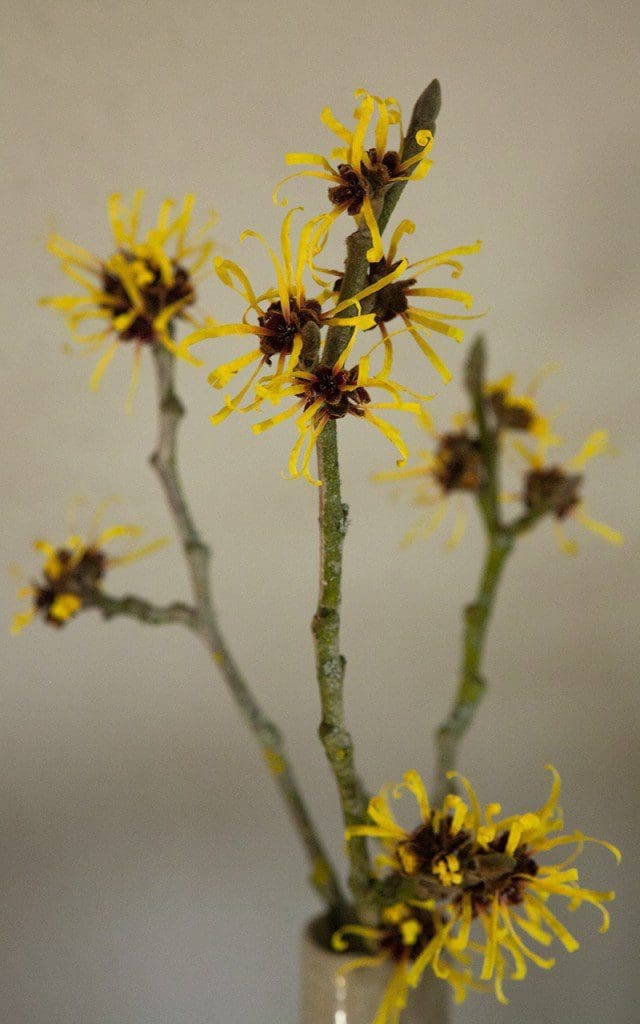 Hamamelis x intermedia ‘Barmstedt Gold’
Hamamelis x intermedia ‘Barmstedt Gold’
Though its ease of cultivation and eagerness to take its own territory, like lilac, is less welcome where space is limited, where you can afford to give it the opportunity to flourish, it is a thing to treasure. I’m pleased to have it at my fingertips for its refusal to bow to the season and have planted it at the end of the barns, on a rubbly mound where an aged bullace stands next to the compost heaps. Little grew there except nettles, but I saw in this leftover place a perfect position to let it take hold.
A little plant, from an easily taken cutting, went in two winters ago and it already has a presence, one arching limb bigger and more fully formed than the next and the flowers springing from the lateral growth of the previous year. It is never fully deciduous until the push of bright new leaves in the spring and the pale, waxy flowers are held amongst a scattering of yellowing foliage. Look closely and the blooms with their splayed yellow anthers are clearly those of honeysuckle and they smell like it too. I will leave the shrub to attain full size at 3 metres and not curtail it by regular pruning, although it responds well to the clippers and makes a fine scented hedge. In time I plan to remove whole branches and bring them into the house. Captured indoors the perfume is pervasive, but never overpowering like that of paperwhites.
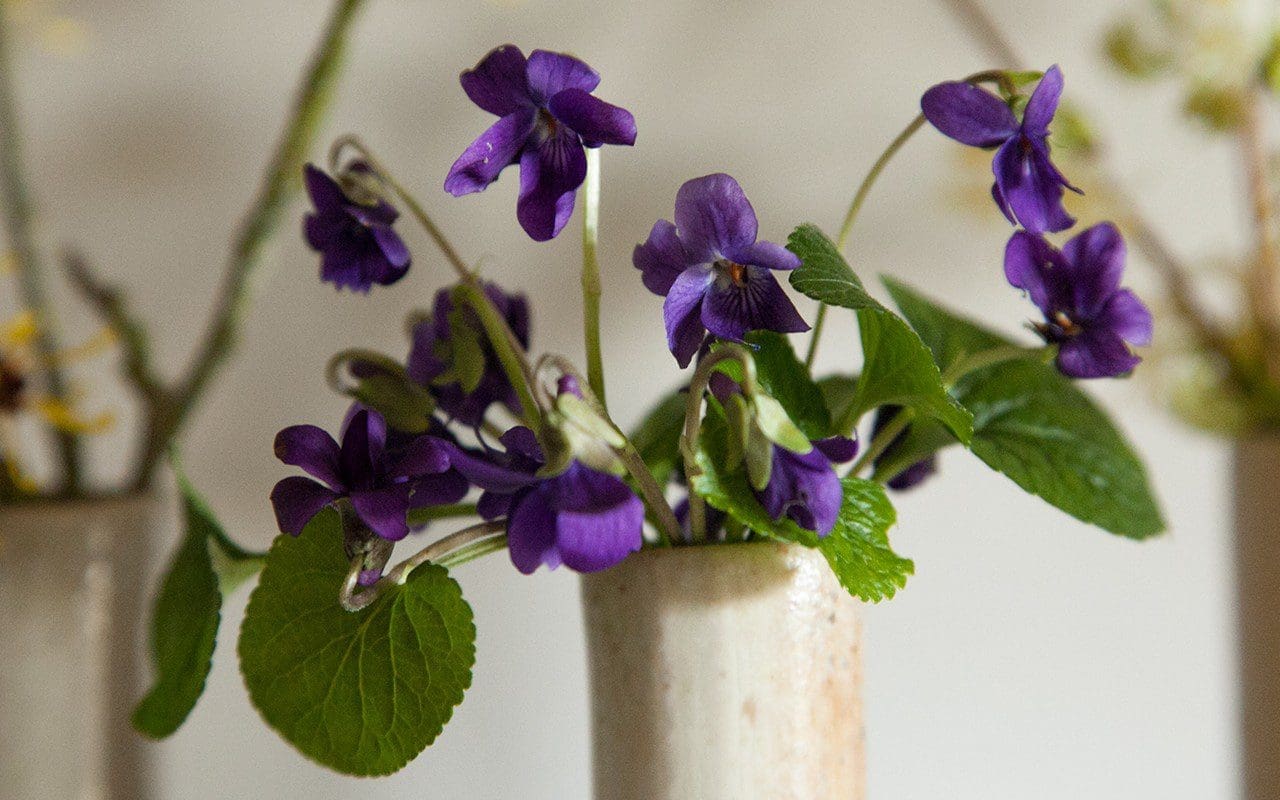 Viola odorata
Viola odorata
I have never quite fathomed why so many winter-flowering plants possess a perfume because, although the scent is designed to attract pollinators from a distance, the majority of insects are in hibernation when they are in flower. However, it is a lovely thing to come upon when you are expecting less. Placing is all important where these moments can be fugitive on winter air, and the perfume of the lonicera is held in the stillness around the barns. As it is hungry at the root I have planted a drift of Viola odorata at its base. I believe them to be florist’s violets from the time when the land here was a market garden. There was a self-seeded colony in the lawn in front of the house, which I saved when the re-landscaping took place last year. Rummage amongst the foliage and the very first flowers are already present, their inimitable powdery scent providing a foretaste of spring. Amongst the viola I am going to add one of the earliest of the snowdrops, Galanthus elwesii ‘Mrs. McNamara’, which also started flowering at the turn of the year and is sweetly scented of honey. Another layer to this winter collection and one that is always welcome at this fallow time.
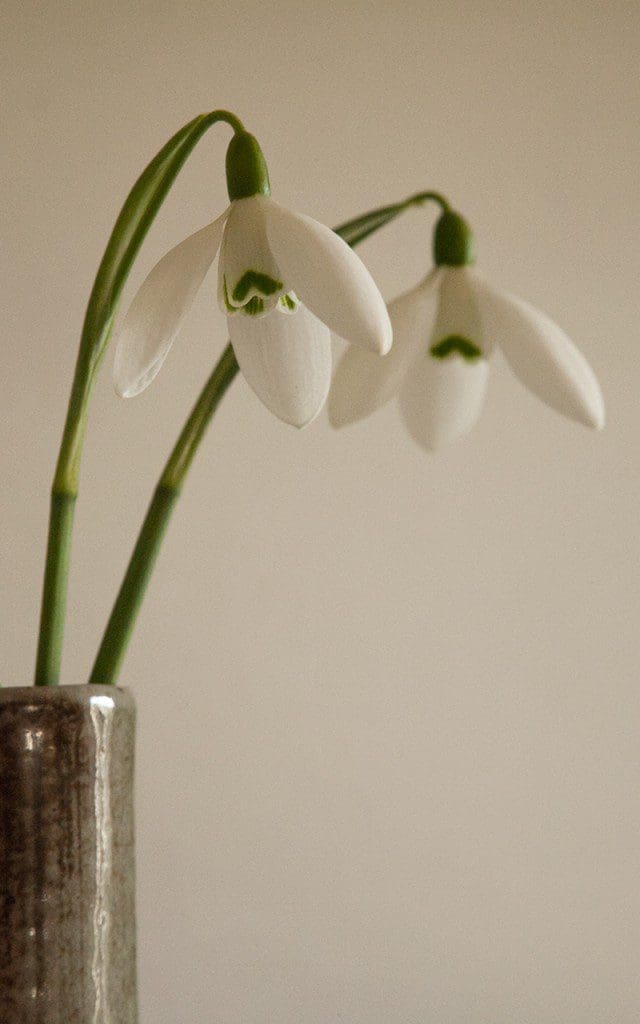 Galanthus elwesii ‘Mrs. McNamara’
Galanthus elwesii ‘Mrs. McNamara’
Words: Dan Pearson / Photographs: Huw Morgan
December reveals the bones of the landscape. Mud where there was grass, bare stems where there was foliage and, by this late in the year, almost everything drawn back and in retreat. Not so the Glastonbury Thorn. Missing the winterising gene that triggers dormancy and stirring when there is barely enough light or warmth to sustain growth above ground, Crataegus monogyna ‘Biflora’ is pushing against the flow. A scattering of young foliage is greening limbs that only recently were fully clothed and a push of pale flowers braving the elements.
Flowering twice, once in spring in celebration of the resurrection and then again at Christmas to mark the birth of Jesus, the habits of the Glastonbury Thorn are understandably surrounded by legend. Joseph of Arimathea was reputed to have visited Glastonbury with the Holy Grail. Thrusting his staff into Wearyall Hill it sprouted and grew into the original tree which, for superstitious reasons, was cut down and burned during the English Civil War. A subsequent tree (planted from cuttings taken by locals and fostered since then in the area) replaced it in 1951, only to be vandalised in December 2010. Its limbs were crudely dismembered and subsequent growth the following March was mysteriously rubbed out. Then, on 1st April 2012 a sapling grafted from a descendant of the pre-1951 specimen was planted again on the site, only to be snapped in half and irreparably damaged sixteen days later.
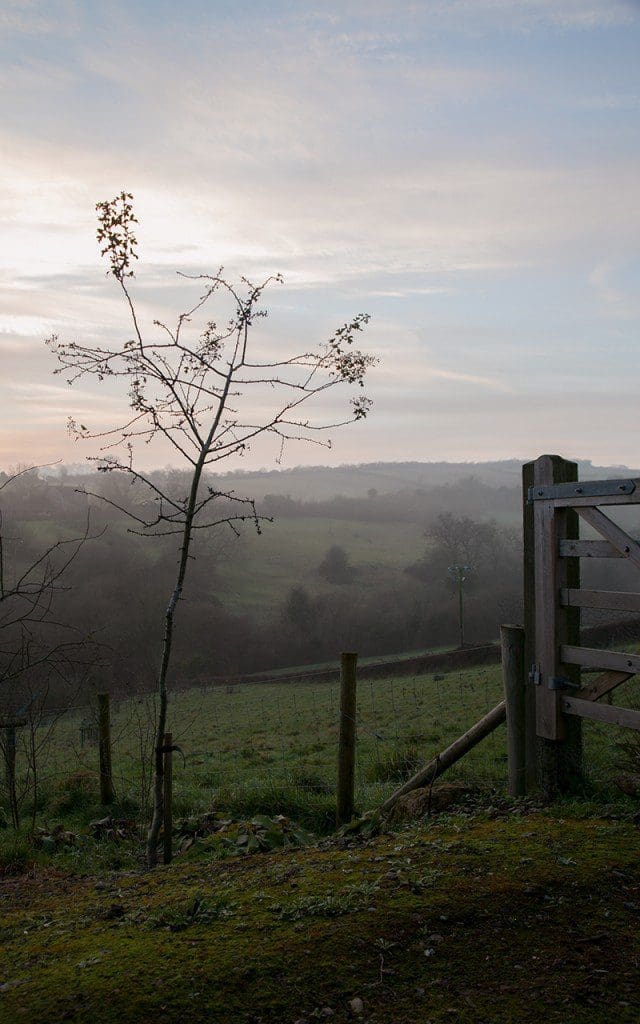 The Glastonbury Thorn by the orchard gate
The Glastonbury Thorn by the orchard gate
As I like a story, and the thought of sweetening a sad one, I set out to find a tree when we moved here to give the magical thorn another stronghold. As all the plants are reputed to come from grafts taken from the original tree, the search revealed how few people grow it and how hard it is to find. Our friend and fellow gardener, Hannah, made me a present of one for my fiftieth birthday and now here it is, by the gate to the pear orchard, in all it’s curiosity.
Though a branch growing in the Churchyard of St. John’s, Glastonbury is taken to the Queen every year on December the 8th by the Vicar and Mayor of Glastonbury, I am too superstitious myself to pick a sprig for the house. Folklore has it that it is unlucky to bring hawthorn over the threshold and, to compound the story, they say the original tree took out the eye of the man who felled it during the Civil War. I like my tree where it is because the flowers draw me out into a closing-down landscape, which is charged just a little by their miraculous show on the darkest days of the year.
Words: Dan Pearson / Photographs: Huw Morgan
We are sorry but the page you are looking for does not exist. You could return to the homepage